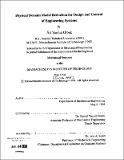Physical domain model reduction for design and control of engineering systems
Author(s)
Orbak, Âli Yurdun, 1970-
DownloadFull printable version (6.432Mb)
Advisor
Kamal Youcef-Toumi.
Terms of use
Metadata
Show full item recordAbstract
There is an increasing need for obtaining low order approximations of high order models of physical systems. Low order models result in several advantages including the reduction of computational complexity and improved understanding of the original system structure. Although different methods have been suggested for obtaining suitable low order approximations, these approaches do not reflect the relation between the mathematical model and the physical components (or subsystems). Specifically, these procedures do not indicate which physical subsystems should be eliminated or retained in a reduced order model. In this work, a new model reduction procedure will be presented. This procedure helps identifying subsystems in a physical system, and accordingly suggests a reduced order model. Subsystems are removed or retained based on information from physical system decomposition procedures and residues. This reduction procedure can also be applied to both SISO and MIMO systems. The residue information can also be used to improve results of existing model reduction methodologies such as the balanced realization techniques. All necessary programming routines for this work were developed in MATLAB and used successfully in several applications. These scripts were prepared in toolbox like functions to enhance their usefulness in a variety of applications. The advantages of the procedure over existing methodologies are emphasized through several examples which include a power steering system.
Description
Thesis (Mech.E.)--Massachusetts Institute of Technology, Dept. of Mechanical Engineering, 1998. Vita. Includes bibliographical references (leaves 107-112).
Date issued
1998Department
Massachusetts Institute of Technology. Department of Mechanical EngineeringPublisher
Massachusetts Institute of Technology
Keywords
Mechanical Engineering